Onsen Tamago, or “hot spring eggs“ in Japanese, are slowly poached in the shell in volcanic hot spring water. This creates the most luxurious, silky egg whites and custard-like yolks. Learn how to make this delicious, easy recipe at home with my foolproof method.
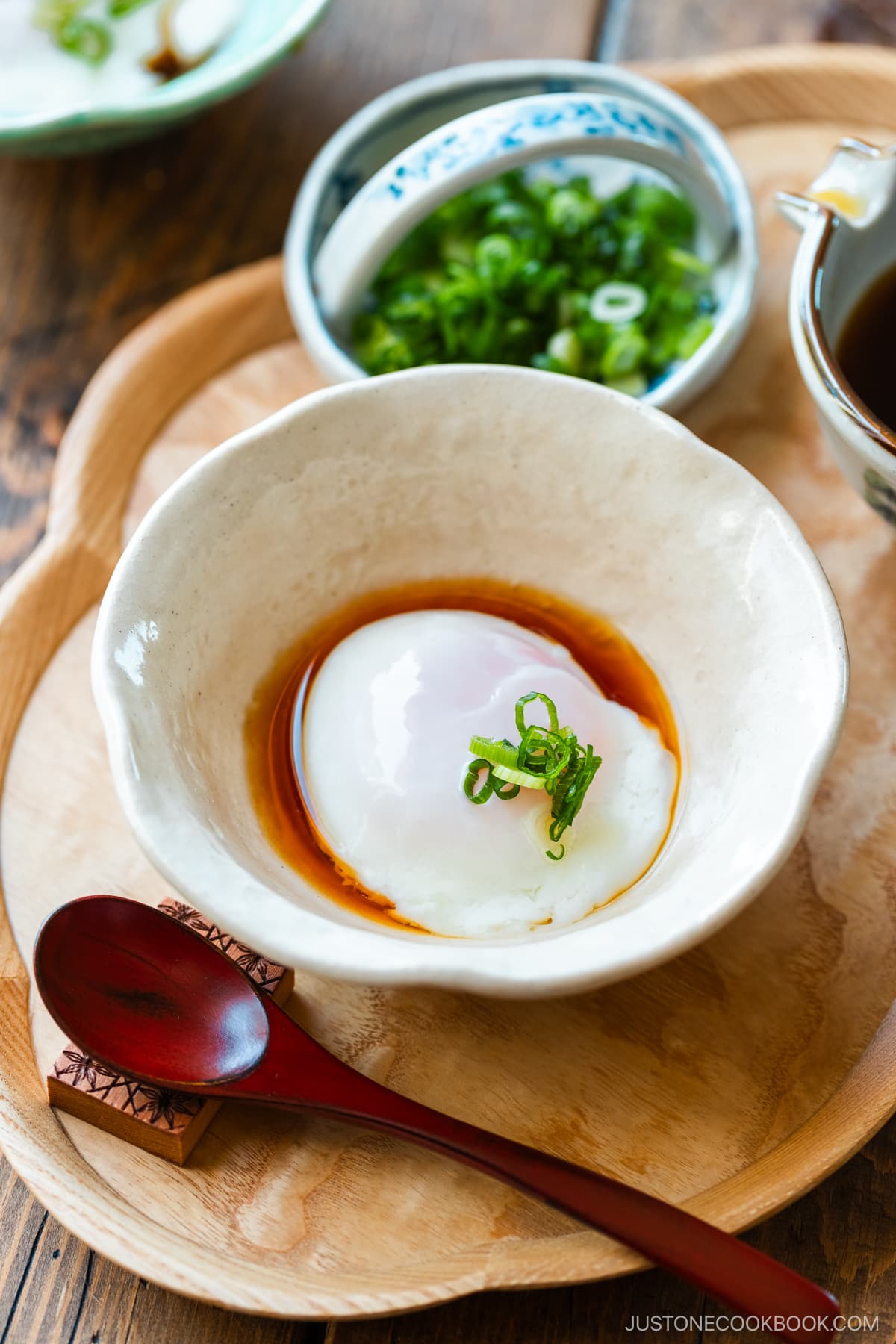
Japan is world-famous for its 30,000+ natural hot springs or onsen. Visitors can take a relaxing and therapeutic bath at one of Japan‘s 3,000 onsen resorts and stay at a resort’s ryokan or traditional inn to experience their warm hospitality and delicious cuisine.
When I stay at a ryokan, one of their breakfast dishes that I eagerly anticipate is onsen tamago (温泉卵, “hot spring egg”). Why? Because this Japanese-style poached egg has the silkiest and creamiest texture. It‘s so comforting and satisfying to eat with hot steamed rice in the morning!
Back in the U.S., I find myself craving onsen tamago. Luckily, it’s easy to make this luxurious egg dish in your own kitchen. Whether you’re an onsen-tamago lover or first-time eater, let me show you my foolproof method today so you can make it at home anytime!
Table of Contents
What’s Onsen Tamago?
In Japanese, onsen means “hot spring” and tamago means “egg.” Onsen tamago (温泉卵), also known as ontama (温玉), is an egg that’s slow-poached in the shell using volcanic hot springs water.
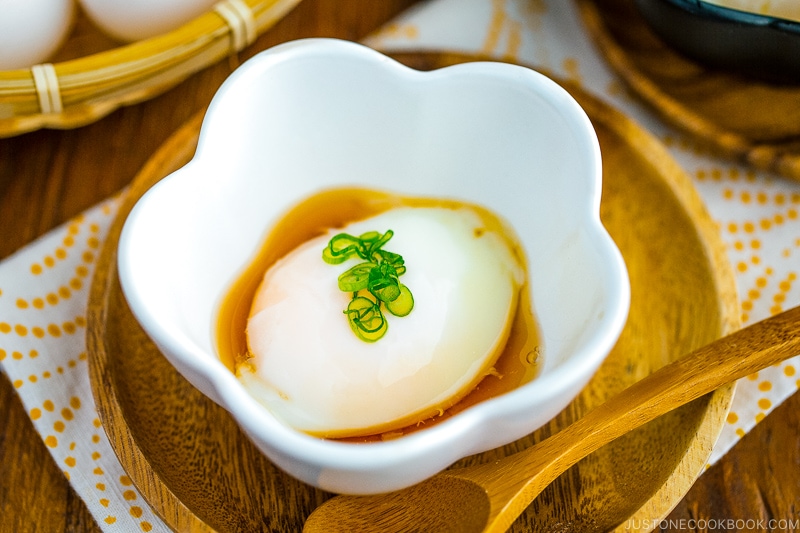
What’s so special about these eggs? They are perfectly poached inside their shell, and the white is silky, creamy, and softer than the half-cooked yolk. This is the opposite of a typical poached egg cooked in simmering water, with a firm white and soft yolk.
The Chemistry Behind Onsen Tamago
We can achieve this special texture because the egg yolk and white solidify at different temperatures. The yolk solidifies at 158°F (70°C) and the white solidifies at 176°F (80°C).
To achieve perfect onsen tamago with creamy and silky whites and soft-cooked yolks, we must cook eggs in hot water at a constant temperature of 149–154°F (65–68°C) for 30 minutes or 154–158°F (68–70°C) for 20 minutes. This mimics the temperature of Japan’s volcanic hot spring waters.
Disclaimer: Many people in the world, including the Japanese, consume uncooked eggs in their cuisine. However, according to the FDA, eggs should be cooked to 165°F (74°C) in order to be considered safe. Please know that the perfect temperature for cooking onsen tamago is below the guideline. There is a risk of salmonella by consuming undercooked eggs.
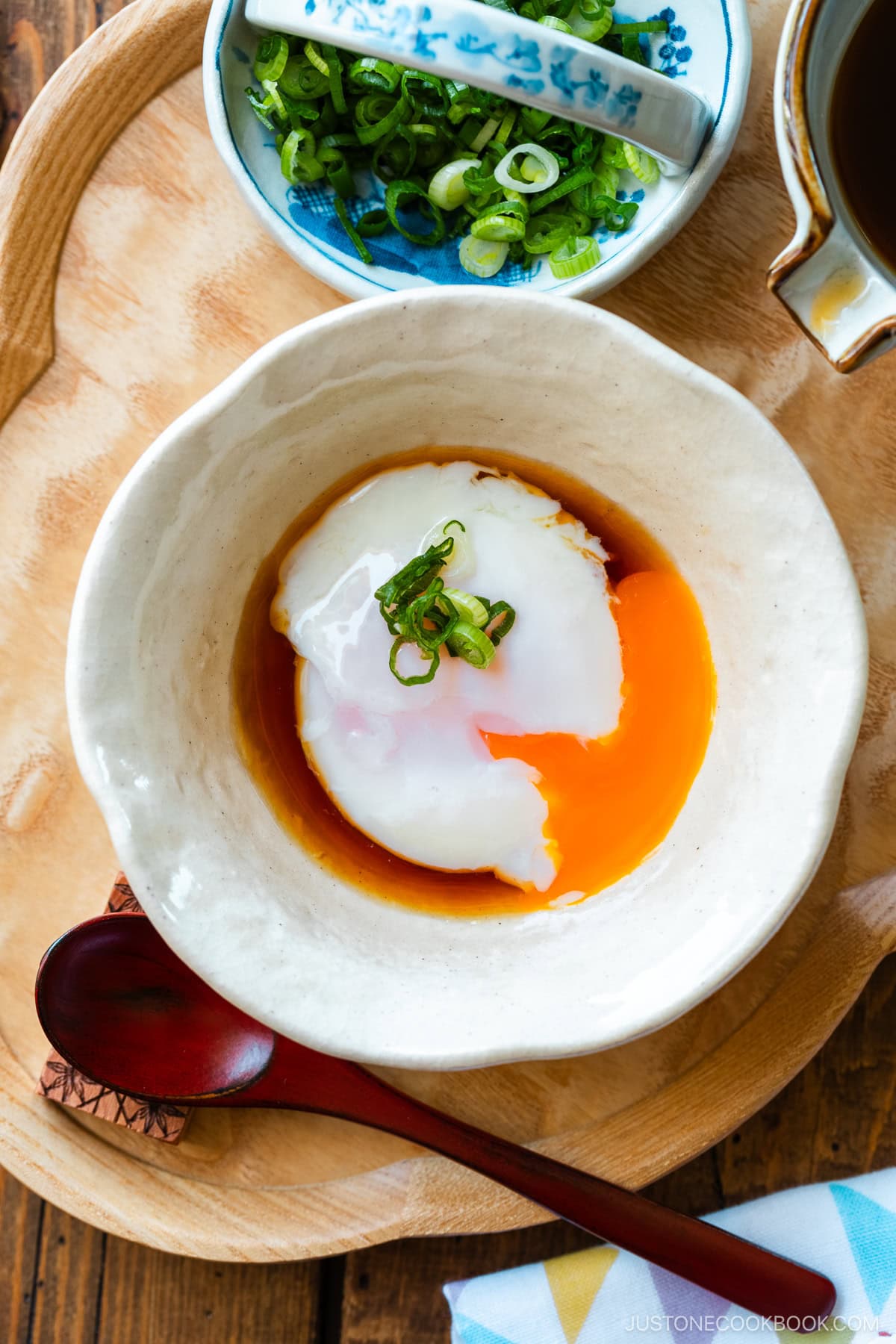
Why This Recipe Works for Everyone
As we don’t have a steady supply of hot spring water at a constant temperature, here’s a method that works for typical home kitchens. This technique does not require special equipment like a microwave, thermometer, or sous vide machine (immersion circulator). It also does not use ice cubes for cooling the cooked eggs; this simplifies things, as some of you don’t keep ice cubes handy.
Here’s what you’ll need:
- A stove, a heavy-bottomed small pot, and a ladle (I use a fine-mesh skimmer). Why a heavy-bottomed pot? It retains heat better.
- Boiling water and tap water to create an ideal starting temperature for the cooking water.
- 4 refrigerated large eggs. Cold eggs offset the higher starting temperature of the cooking water. Some recipes require eggs at room temperature, but our readers’ kitchens have different temperatures depending on where they live, and I wanted to avoid the extra uncertainty.
If you follow my recipe precisely, you will achieve perfect onsen tamago as the final result. If you change the recipe, it will affect the water temperature and you may not achieve a perfect outcome.
🙋🏻♀️ Also, keep in mind that you can customize the firmness of the yolk by increasing or decreasing the cooking time.
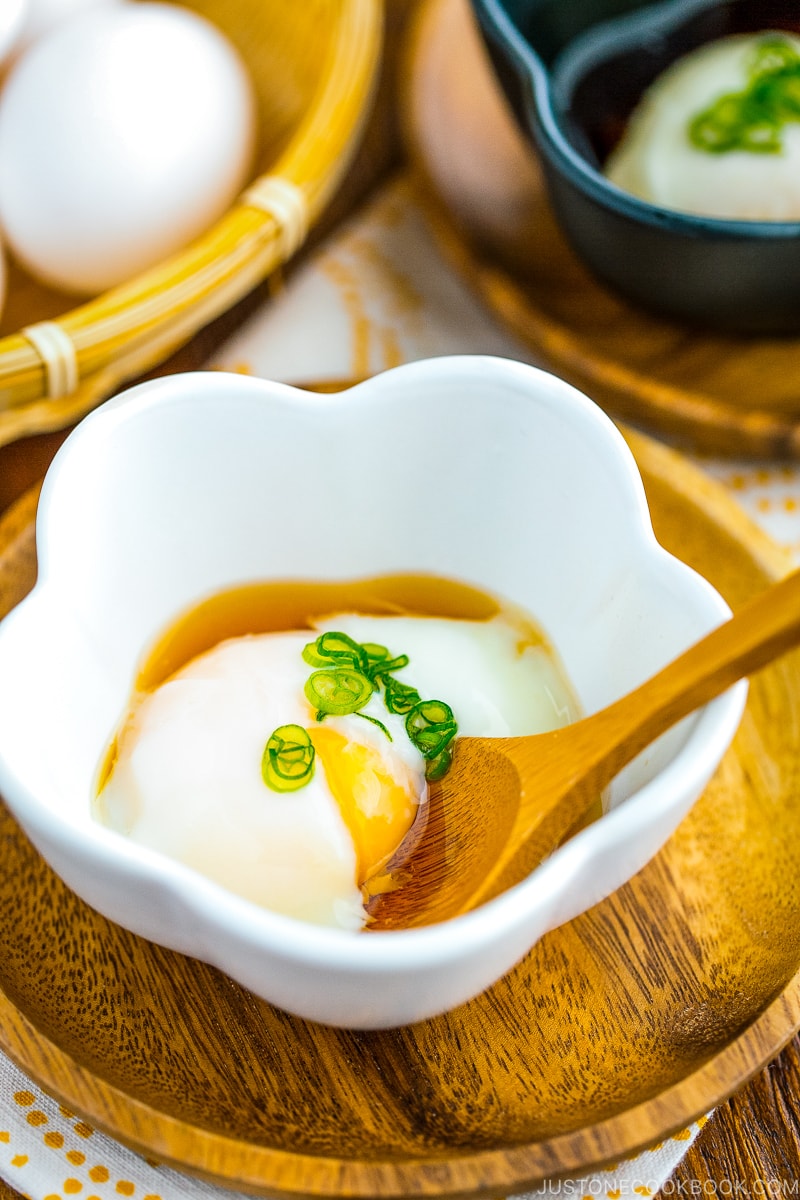
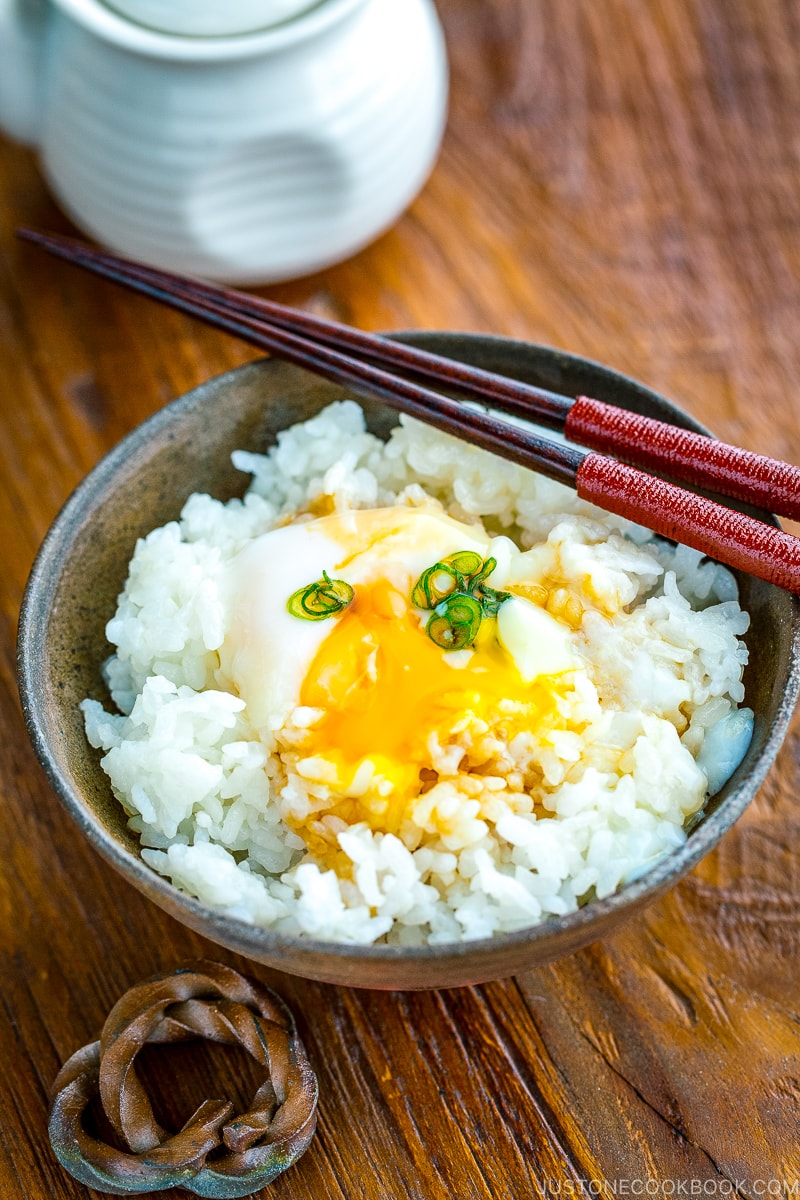
How to Make Onsen Tamago
Here are the simple instructions on how to make perfect onsen tamago without a thermometer or immersion circulator.
- Prepare the cooking water: Boil 4¼ cups (1000 ml or 1 L) of water in a small heavy-bottomed pot. Once boiling, remove it from the stove. Add ¾ cup (200 ml) of cold tap water (65°F/18°C) to the boiled water.
- My hot water temperature at this stage was 180°F (82°C).
- Cook the eggs: Gently submerge 4 refrigerated large eggs, one at a time, in the hot water. Cover the pot, set a timer, and poach for 17 minutes for a runnier yolk and 20 minutes for a creamier yolk.
- My hot water temperature gradually declined to 154–158°F (68–70°C).
- Remove from the water: Open the lid, remove the eggs from the hot water, and set aside for 5 minutes. The residual heat will continue to cook the eggs.
- The water temperature was 154°F (68°C) when I opened the lid after 20 minutes.
- Ready to serve: Serve warm or at room temperature with a drizzle of the dashi soy sauce or add one to curry rice, noodle soup, a hambagu meal, a rice bowl, or a plate of cold noodles.
FAQs
What if I don’t have a heavy-bottomed pot?
A lightweight or thin-bottomed pot is usually made with materials that may heat up and cool down more quickly than heavy-bottomed pots. Therefore, try using less cold tap water, about ⅓–½ cup (100–150 ml) instead ¾ cup (200 ml). If you try this method, keep us posted on your results in the comments below.
Can I use medium eggs?
Since they are smaller, they will cook faster. Please shorten the cooking time. FYI, a large egg without the shell is 50 grams.
How to Serve Onsen Tamago
Onsen tamago with a dashi-based soy sauce (だし醤油) is a typical choice of egg to serve for Japanese breakfast.
You can also serve onsen tamago in various dishes. I adjust the onsen tamago’s cooking time to cook the egg yolk more or less depending on how I use it. For example, I prefer a runny yolk on Japanese curry and a firmer yolk on hambagu.
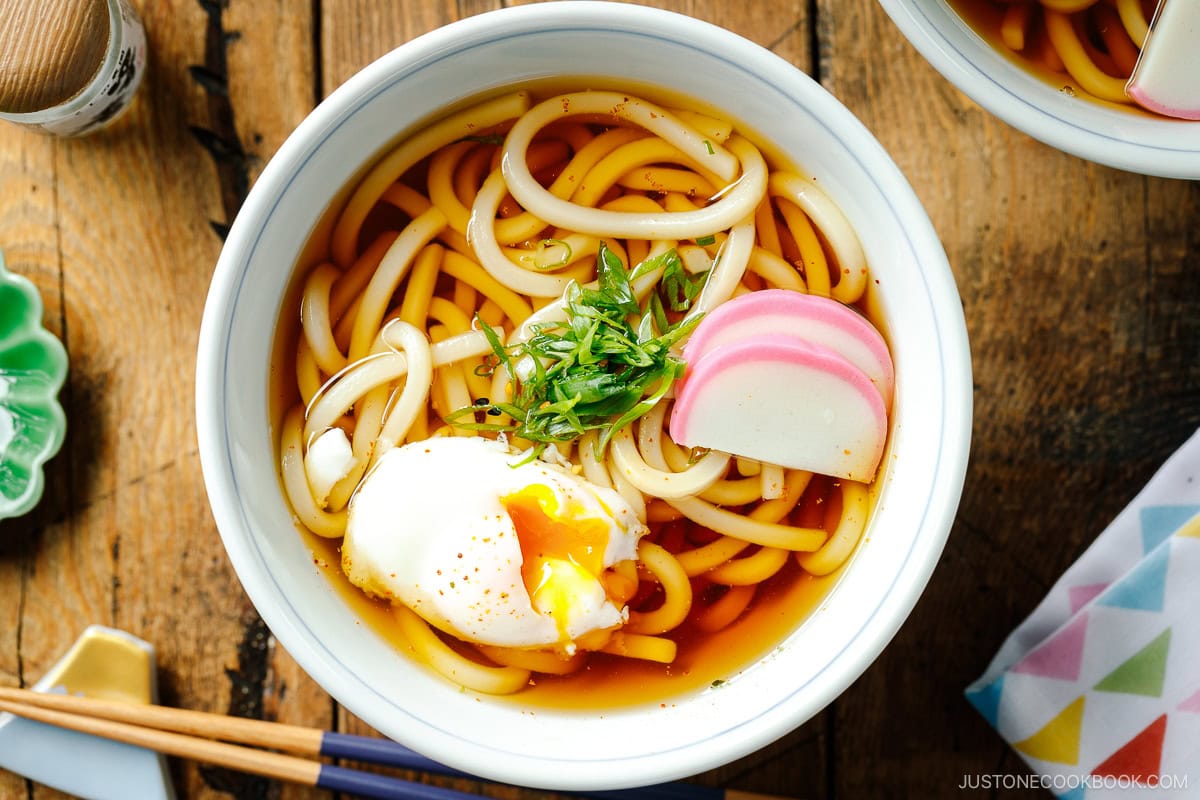
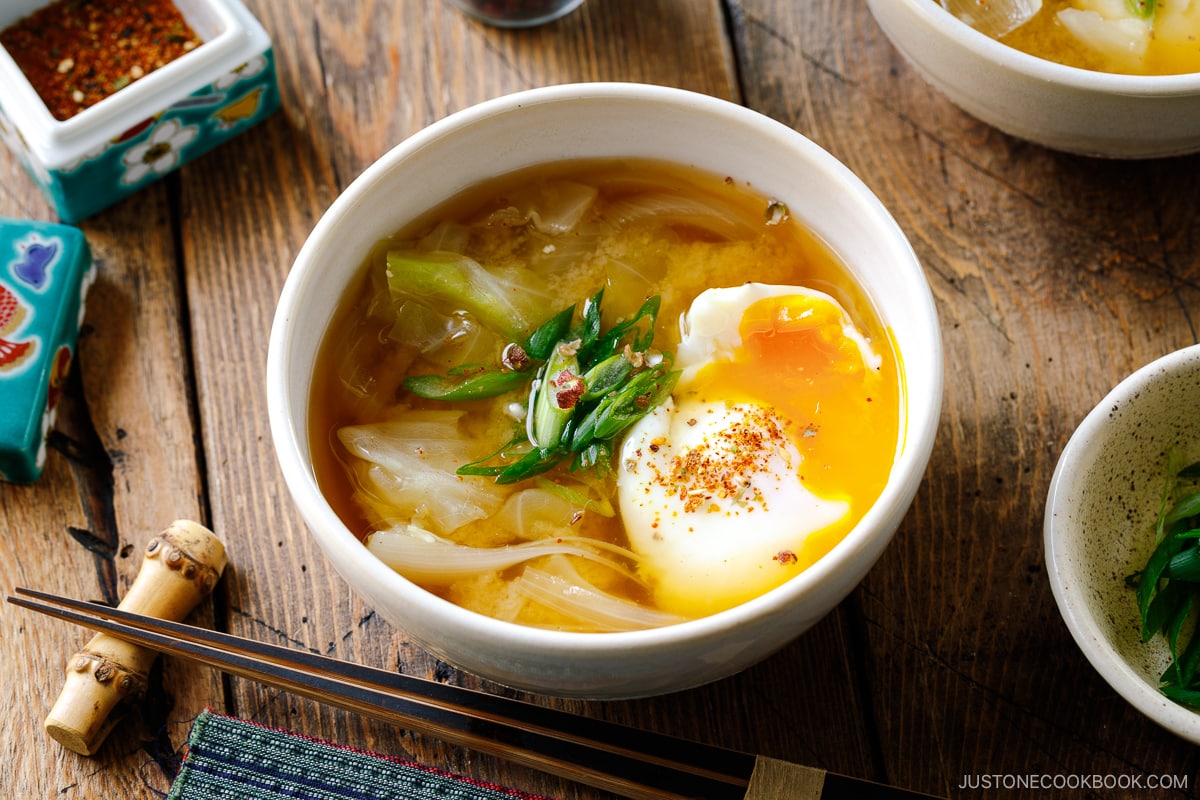
Here are some of my suggestions:
- Put it over fried rice: Kimchi Fried Rice, Garlic Fried Rice
- Top your Japanese curry rice: Japanese Dry Curry, Keema Curry, Chicken Curry, Vegetarian Curry, Beef Curry
- Add it to a rice bowl: Gyudon, Yakiniku Don, Tamago Kake Gohan
- Put it in noodle soup: Kake Udon, Cold Tanuki Udon, Vegetarian Udon, Soba Noodle Soup, Miso Ramen, Vegetarian Ramen, Shoyu Ramen, Mazesoba (brothless ramen)
- Top a main dish: Hambagu (Japanese hamburger steak), Nikomi Hambagu (stewed hamburger steak), Loco Moco, spaghetti carbonara (my favorite), Avocado Toast
- Put it in your soup and hot pot: Classic Miso Soup, Cabbage and Onsen Tamago Miso Soup, Cold Miso Soup (Hiyajiru), Zosui (Japanese rice soup), Nabeyaki Udon, Miso Nikomi Udon

Wish to learn more about Japanese cooking? Sign up for our free newsletter to receive cooking tips & recipe updates! And stay in touch with me on Facebook, Pinterest, YouTube, and Instagram.
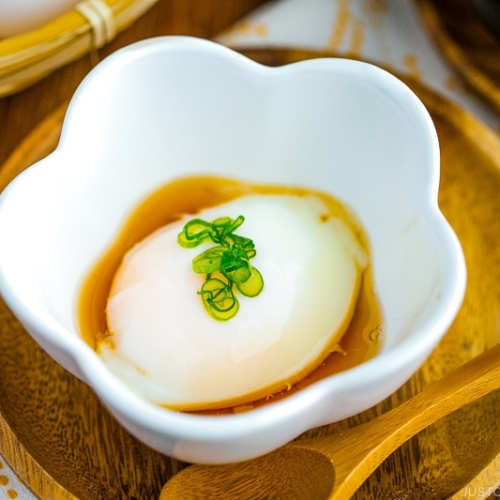
Onsen Tamago (Japanese Hot Spring Egg)
Video
Ingredients
- 4¼ cups water (1 L)
- 4 large eggs (50 g each w/o shell) (refrigerated)
- ¾ cup tap water (200 ml; colder than room temperature)
For the Sauce
- ¼ cup dashi (Japanese soup stock) (4 Tbsp; use standard Awase Dashi, dashi packet or powder, or Vegan Dashi)
- ½ Tbsp mirin
- 1½ Tbsp soy sauce
- 2 Tbsp katsuobushi (dried bonito flakes) (skip for vegetarian)
For the Garnish
- green onion/scallion
Instructions
- Before You Start: You must use a small, heavy-bottomed saucepan (I use All-Clad Copper Core 2 QT saucepan) that retains heat well and is small enough to completely submerge the eggs in the measured water. If you don‘t have one, please see my FAQs section of the blog post for my suggestion. Also, you need exactly 4 refrigerated large eggs for this recipe to achieve the correct water temperature for poaching. Now, gather all the ingredients.

To Poach the Eggs
- To the heavy-bottomed saucepan, add 4¼ cups water (1 L). Cover with a tight-fitting lid and bring it to a boil.

- Once boiling, turn off the heat and remove the pot from the stove. I moved my saucepan to a hot pad on my countertop. Next, remove 4 large eggs (50 g each w/o shell) from the refrigerator.

- To the pot of just-boiled water, add ¾ cup tap water (200 ml) that's colder than room temperature and stir. The hot water in the saucepan should be roughly 180°F (82°C). Then, gently submerge the cold eggs, one at a time, into the hot water using a fine-mesh skimmer. Tip: If you‘re using a lightweight or thin-bottomed pot, try adding only ⅓–½ cup (100–150 ml) of cold tap water instead.

- Immediately cover with the lid and set a timer for 17–20 minutes. Poach 17 minutes for runnier yolks and 20 minutes for creamier yolks. If you follow my method precisely, the water temperature will be 154°F (68°C) when you open the lid after 20 minutes. Note: If you prefer a firmer yolk, you can experiment with a longer poaching time.

To Make the Sauce
- Meanwhile, make the sauce. Combine ¼ cup dashi (Japanese soup stock), ½ Tbsp mirin, 1½ Tbsp soy sauce, and 2 Tbsp katsuobushi (dried bonito flakes) in a small saucepan and bring it to a boil.

- Once boiling, turn off the heat.

- Strain through a sieve and set the sauce aside.

To Finish the Onsen Tamago
- After 17–20 minutes, gently take the eggs out of the water, one at a time. Set them aside for 5 minutes. The residual heat will continue to cook the eggs.

- Meanwhile, cut the green onion/scallion into thin slices and set aside.

To Serve
- Enjoy the Onsen Tamago either warm or at room temperature. Crack the egg into a small bowl, pour the dashi-based sauce into the bowl, and garnish with the sliced green onion as a part of a Japanese breakfast. Try the egg on top of steamed rice with a splash of soy sauce. It’s also delicious in a rice bowl, on top of Japanese curry rice, in hot noodle soup, or on a plate of cold udon or ramen noodles. See below for serving ideas.

To Serve Onsen Tamago in Other Dishes
- Top a rice dish: Onsen Tamago is a protein-rich topping for fried rice like Kimchi Fried Rice and Garlic Fried Rice. Try adding one to finish a Japanese curry rice plate like Japanese Dry Curry, Keema Curry, Chicken Curry, Vegetarian Curry, and Beef Curry.
- Add it to a rice bowl: It‘s a silky and rich topping for Gyudon (simmered beef bowl) and Yakiniku Don (grilled beef bowl). It also works beautifully in a poached-egg version of Tamago Kake Gohan.
- Put it in noodle soup: Up the protein and add one to your Kake Udon (classic udon noodle soup), Vegetarian Udon, Cold Tanuki Udon, and classic Soba Noodle Soup. It‘s also great in Shio Ramen, Miso Ramen, Vegetarian Ramen, Shoyu Ramen, and Mazesoba (Japanese brothless ramen).
- Top a main dish: Add one to your Hambagu (Japanese hamburger steak), Nikomi Hambagu (stewed hamburger steak), Loco Moco, and spaghetti carbonara (my favorite). It also works well on Avocado Toast.
- Put it in your soup and hot pot: Bulk up your Japanese soups by adding one to classic Miso Soup, Cabbage and Onsen Tamago Miso Soup, Cold Miso Soup (Hiyajiru), and Zosui (Japanese rice soup). It‘s delicious in Nabeyaki Udon, Miso Nikomi Udon, and Hot Pot for One, too.
To Store
- You can keep the uncracked Onsen Tamago for 1–2 days in the refrigerator. To reheat, remove it from the refrigerator and bring it to room temperature. To warm it up further, place it in a bowl of 160ºF (70ºC) water for 10 minutes. Do not reheat higher than that; otherwise, the heat will cook the egg. Keep any leftover sauce in the refrigerator for 4–5 days.
Nutrition
Editor’s Note: This post was originally published on January 22, 2015. It was republished with a new video, new images, and more helpful content on April 19, 2024.
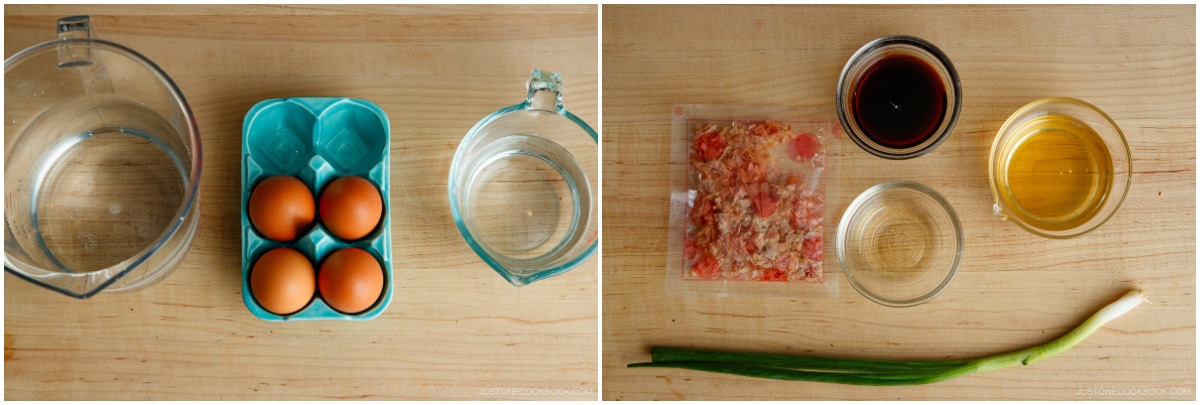
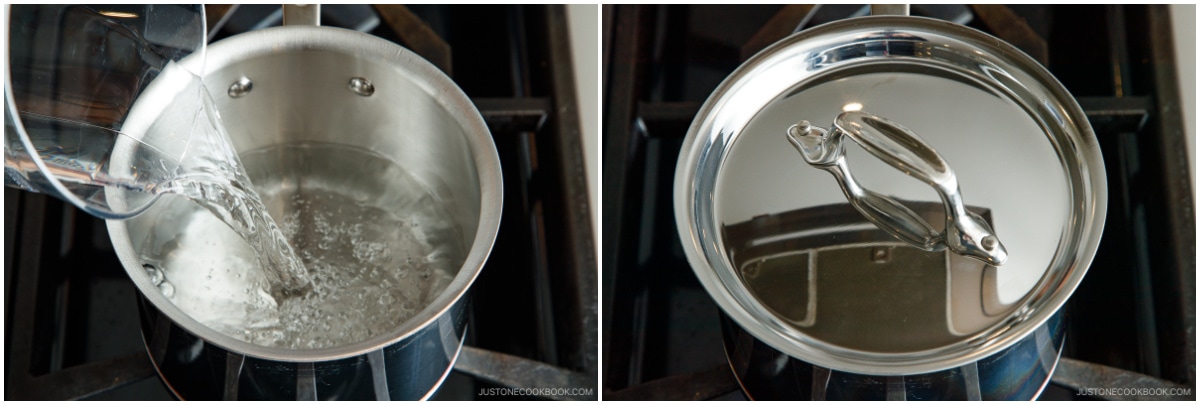
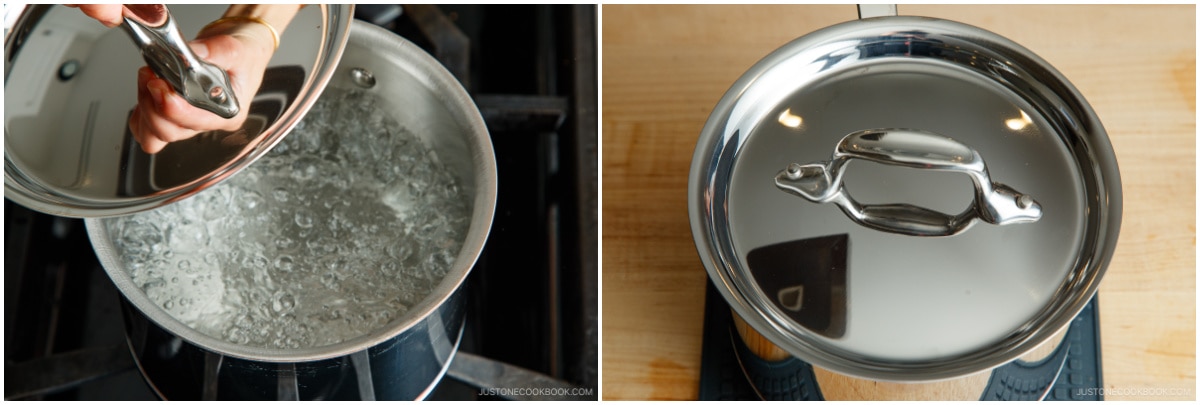
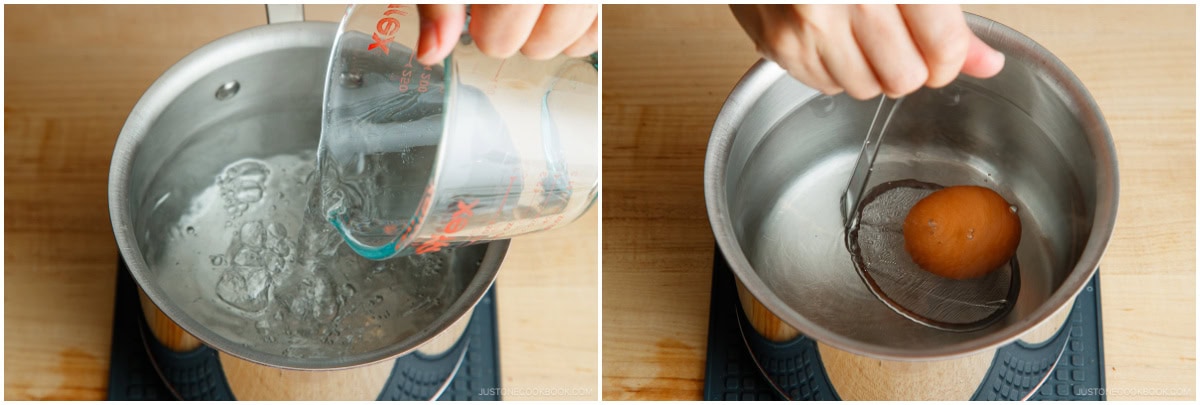
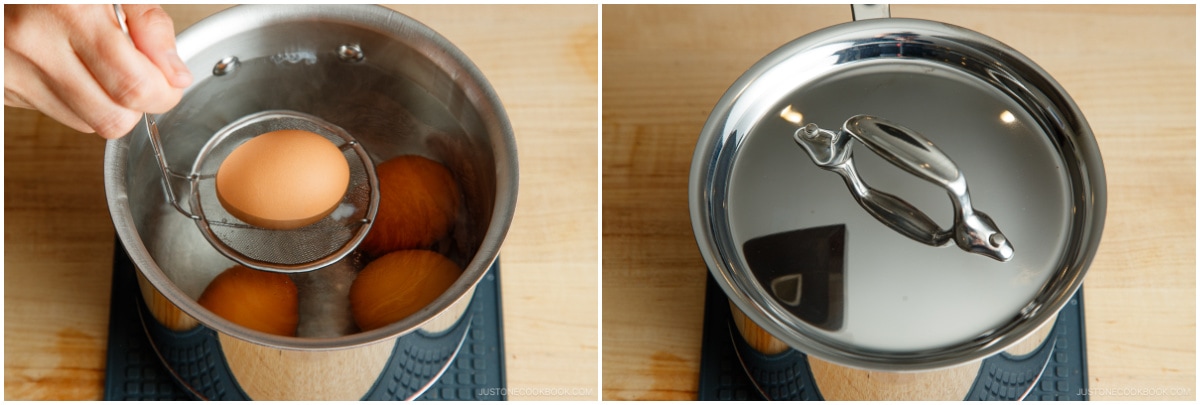


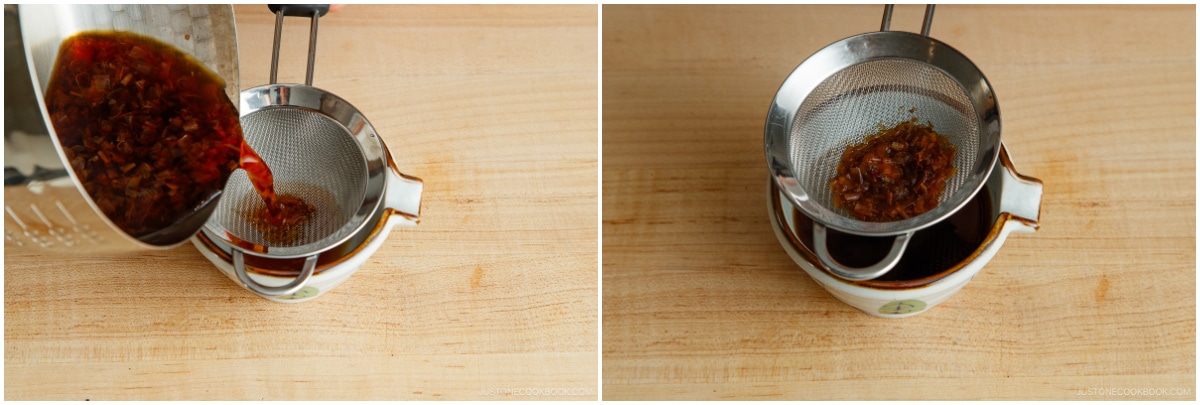
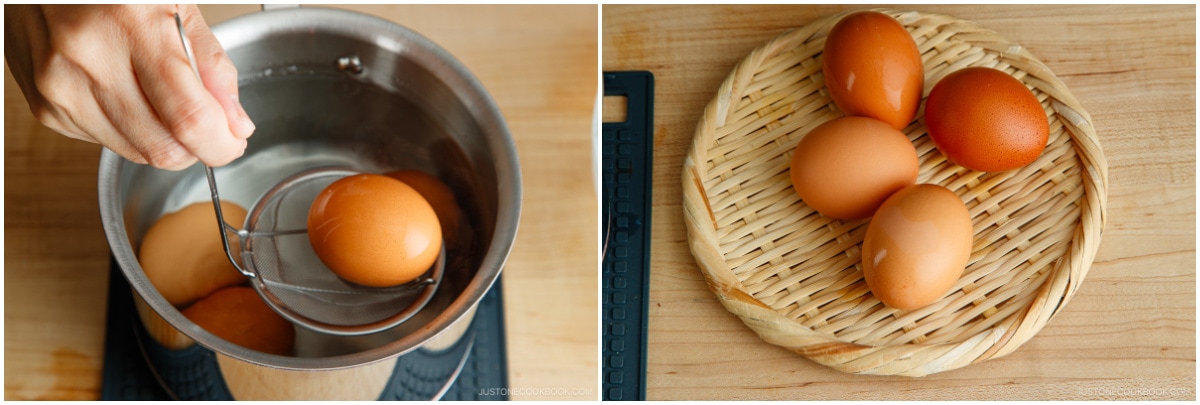
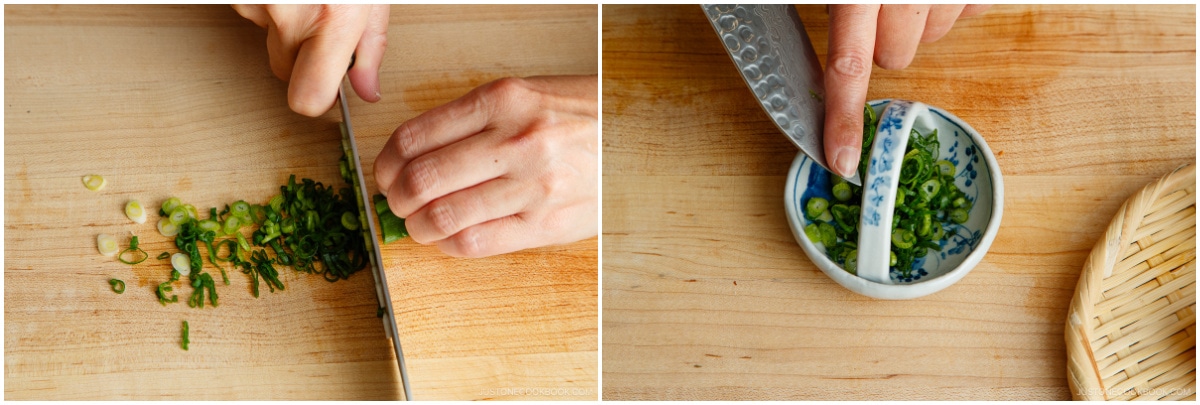
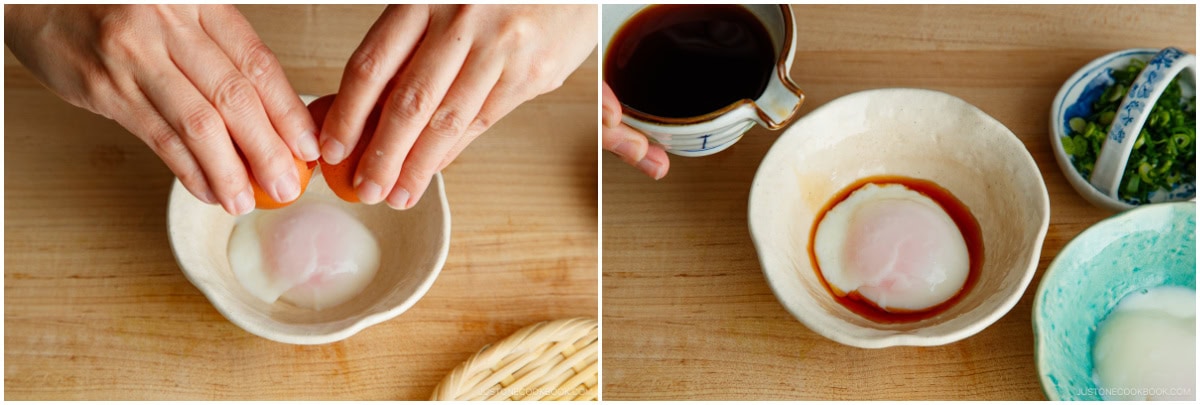











For those of you who live at a high altitude (my home ~6,200ft), I tended to get the best results with 21 minutes
Hi O. Cornali, Thank you so much for trying Nami’s recipe and sharing your experience with us.
This helps other readers who live at high altitudes. Thank you very much!
Mine did not come out whole. The whites were stuck to the shells. The yolks were perfect though. Any ideas on what might have gone wrong? Thank you!
Hi Andrea! Sorry it didn’t come out well. Although I’m not 100% sure what went wrong as I wasn’t there with you in the kitchen, but I heard one reason why egg whites get stuck with the shells. If you have just bought these eggs and made this recipe, it’s possible that your eggs were too fresh. It’s funny, but to make this egg or boiled eggs, it’s easier to use a little bit older eggs (I remember reading somewhere that we should use the eggs in the fridge for at least a week) as shells come off nice and easy (You can probably google about it). However, I have made this recipe with fresher eggs (ones I bought from a store), and didn’t have this issue… So to be honest with you, I’m not too sure… Sorry I wish I could help.
This exact problem happened to me! Otherwise the eggs turned out great tastewise but just didn’t look as good. The yolk was separated from the white which were in pieces some stuck to the shell.
Hi Jen! So the egg white was cooked and attach to the shell? Is it possible it’s overcooked so it is more like hard boiled egg? Did you use refrigerated eggs? It’s important that they were not at room temperature as the starting point would be at different temperature.
Finally the mystery behind the onsen tamago is revealed to me after over a decade when i encountered them at a hot springs in Japan. I thought it was just the novelty of hot spring boiled eggs. I never tried as i am intolerant to eggs although i love them (looking at recipes to cook for someone else). I think my nephew will love these as he loves poached eggs.
Hi Kenny! Aww I’m so glad this post give you a closure. 😀 I hope your nephew will enjoy Onsen Tamago. 🙂
I finally made onsen tamago using your recipe. It is spot on and I loved how the egg slipped out whole when you crack the egg in two. I am pointing my friends to this direction as they are asking me how I did it. Thanks Nami!
HI Maricel! I’m so glad to hear your onsen tamago came out well! Thank you so much for writing your kind feedback and referring your friends to my site. You’re too kind! Thanks for your support! 🙂
My eggs cracked as soon as they hit they water. Is it possible that my cold water wasn’t cold enough to cool it and the temperature change from the fridge to the water was too drastic?
Hi Samantha! I always make it this way and I have no issues. It’s obvious but just in case… you didn’t drop it right? Make sure to lower the egg one by one using a ladle or slotted spoon to place on the bottom of the pot, not “dropping off”.
I finally made it! 🙂 I failed the first two times, and I got almost hard boiled eggs… Later I discovered that I actually missed out adding 200ml tap water in step 2… haha~ So I tried again yesterday night, and I.made.it!! 🙂 So so happy~ The next time I do it again I’ll take a picture of it and show it to you on your FB 🙂
Hi Jessica! Haha! Yeah the water is to lower the temperature (without using a thermometer). 😀 I’m glad yours came out well. Thanks so much for trying this recipe. Yep, I look forward to your photos! 😉
Hi, Eggs are my favorite. I will try the 17 minute method of cooking and use the sauce receipe you provided.
Thank You.
Hi Alexandria! Hope you enjoy this recipe! 🙂
Thank you so much for posting this! I made this with two eggs and added them to soup and it was one of the best and most comforting breakfasts I’ve made myself in awhile!
I’m so happy to hear you enjoyed this recipe! Thanks you very much for your kind feedback! 🙂
You always make it look so easy. I definitely want to give this a try if I can get my hands on some really fresh eggs. I am sure I can eat all 4 in one sitting but I probably shouldn’t….
Thank you Kit! Hope you enjoy this recipe! 🙂
I’ve lived in Japan 42 years and recipes like this are a wonderful way to help others enjoy our great food. Keep motivated, keep cookin’
Thank you so much, Joe!
Hi Nami,
I tried your Onsen Tamago recipe of today with one egg. It turned out perfect and exactly how I like my soft-boiled eggs. Thank you!!
Hi Marguerite! I’m so glad to hear it worked! Thank you very much for your kind feedback! 🙂
If the water in the pot is 176 degrees °F (80 °C), you can safely put in a single egg and up to four given your 1 Litre (quart+-) of boiling water + 250ml (1 cup) tap water. The thermal mass of the water is what is needed to properly cook the eggs. Adding a 5th egg will probably lower the water temperature too much & affect the outcome.
I think that using the amount of water specified, 1-3 eggs of any size can be safely cooked, maybe not for the 4th because the weight of the eggs would cause the water/egg weight ratio to be changed.
However, if you increased the amount of boiling water and tap water in their 4 to 1 ratio, you can cook a larger number of eggs properly.
If you have a sous-vide machine – just set the temperature to 149-154 degrees °F (65-68 °C) & wait 17+ minutes.
You may need to do a test run, but it isn’t rocket science.
PS. I just gave up poaching eggs (in water). This is much easier, less mess.
Thank you Al! I got a sous-vide machine so I look forward to testing with it too. 🙂
Appreciate this comment; I am immune suppressed and so cannot really tolerate the risk for undercooked eggs. Four at a time sounds right, so likely I’ll just increase the water amount a little for safety when I get around to this one.
This looks delicious, but is the egg cooked through? If I served this to my mother she’d freak lol, so I was just wondering c:
Hi Kathryn! Well it’s not cooked “fully” so it’s probably not for your mother. 🙂
Wow, thank you! I always wondered how these eggs were prepared at the Japanese hotels (had them at some breakfast buffets).
Hi Wendy! It’s actually very simple (simpler) than making a regular poached egg I think. 🙂 Hope you try this recipe at home!
Goodness yes, this is FAR simpler than poaching eggs, speaking from professional experience. One of the biggest nightmares every chef has is poaching eggs to order. That same nightmare usually includes Mother’s Day. Onsen eggs are a cakewalk by comparison. 🙂
Hi Robert! Aw I’m happy to hear from a chef! Thank you so much for your comment and confirming onsen tamago is easier. 😀 Haha, it’s funny you mentioned about Mother’s Day. I wonder how many orders of poached eggs you have (had) to make on that day…. 🙂
Such a nostalgic dish! I can’t wait to make it but I know that I’ll have to make it often for my husband! Thank you for sharing!
Hi Donna! Hope you like this technique and your husband will enjoy this onsen tamago. 🙂 Have a wonderful weekend, Donna!
Hi and thanks so much for a great site.. Well done!
I love the sound of this recipe but I would MUCH rather cook them the traditional way.. Ah Japan….
Hope your utube session come together ok and you still have time for a bit of weekend : )
Hi Sally! You mean cooking in the hot spring water? Yeah that’s the best, especially after soaking in onsen before breakfast and breakfast is served… Haha! I miss it….. 🙂
Thank you very much for your encouragement! I’m going to continue tomorrow, too!
I LOVE onsen tamago. I followed several different ways to make this – this is the by far the easiest! (I love it with rice and a sprinkling of pepper from Nagano.)
Hi Lydia! I’ve done the same, but this method has been the best one that works for me and I hope it’ll be the same for my readers. 🙂 That’s a very nice simple way to enjoy onsen tamago! 🙂
I followed the directions pretty closely with 1000ml of boiling water and 200 ml of tap water: 4 refrigerated eggs at 17 minutes and then testing for 5 minutes. All 4 eggs were still clear with just the edges a bit cloudy… And the took was raw. What do I need to do differently?
*yolk was raw
Hi Lenore! Thank you for trying this recipe. I would adjust reducing 200 ml water and cooking time. Don’t change your pot while you test. You should not change other things and always use the same equipment. I’m sorry yours didn’t work. I wasted a lot of eggs, hoping that I did all the testing for everyone, but I can’t control the condition for everyone. One day I’ll share a recipe using a thermometer. 🙂
This is substantially late to the party but I haven’t seen it mentioned. Keep in mind altitude will affect this recipe greatly. In San Francisco that boiling water will be starting at 212F in Denver it’s only going to be 203F.
Hi Nocturnal! Thank you so much for sharing this information! I’m always curious about how people in high altitude adapt recipes.
That got me thinking…I wonder if food bloggers in higher altitude write recipes in high altitude cooking. Sometimes I don’t check where the food blogger is located and check the recipe directly.
In case this step was missed out; following the instruction closely, do note the water is to be IN the pot that put over the stove to boil it, in this case the pot is heated up togather with the boiling water.
The water must not be e.g. boiled using a kettle and pour into a pot, this pot is in cool temperature in its original state, not heated up therefore will affect the outcome of the eggs.
Hope this help others to take note when following the steps. We may overlook this.
Thank you for your input, Angie!